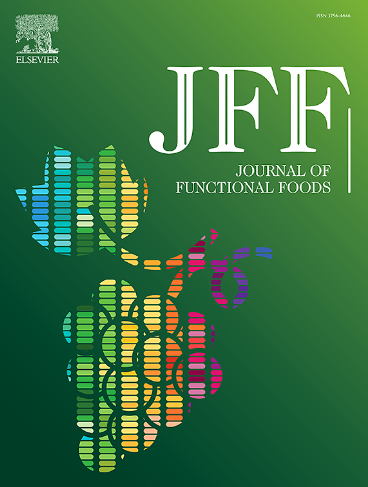绿茶提取物对老年性听力损失耳保护作用的蛋白质组学分析
IF 4
2区 农林科学
Q2 FOOD SCIENCE & TECHNOLOGY
引用次数: 0
摘要
背景:年龄相关性听力损失(age -related hearing loss, ARHL)是一种非常常见的伴随年龄增长而导致听力损失的复杂疾病。ARHL严重影响老年人的认知和生活质量。目前还没有治疗或预防ARHL的理想方法。绿茶及其有效成分可以降低与年龄有关的疾病的风险。目的:研究绿茶及其重要活性成分表没食子儿茶素没食子酸酯(EGCG)对ARHL的影响,并揭示其分子机制。方法:连续9个月给予C57BL/6 J小鼠绿茶提取物(GTE)和EGCG。本研究中使用的绿茶提取物的剂量符合人体可接受的摄入量,并且在已知的安全范围内。对听力的影响是通过听觉脑干反应来测量的。随后,利用4D无标记蛋白质组学检测GTE和12 m组耳蜗蛋白的表达。差异蛋白表达通过火山图分析可视化。对GO和KEGG途径进行富集评估,以揭示其生物学作用和分子途径。此外,使用PPI网络和VarElect分析这些差异表达中的蛋白质,增强基于评分标准的关键蛋白质的识别。结果:gte处理小鼠听力优于对照组,而egcg处理小鼠听力无明显改善。gte处理小鼠耳蜗组织形态较对照组改善,螺旋神经节神经元损伤较小。4D无标记蛋白质组学用于评估蛋白质组学模式。在gte处理的小鼠耳蜗中发现了大量差异表达蛋白(59)。通路分析进一步表明,这些DE蛋白参与细胞质dna传感通路、剪接体、Rap1信号传导以及牛磺酸等多种物质的代谢过程。结论:长期补充GTE可通过多种途径改善小鼠ARHL,提示ARHL治疗存在一定的药物靶点。本文章由计算机程序翻译,如有差异,请以英文原文为准。

Proteomic analysis of the Otoprotective effects of green tea extract on age-related hearing loss
Background: Age-related hearing loss (ARHL) is a very common complex disease that causes hearing deficits with age. ARHL seriously affects the cognition and quality of life for the elderly. An ideal method of treating or preventing ARHL is currently unavailable. Green tea and its active ingredients can reduce the risk of age-related diseases.
Objective: This study aimed to evaluate the effect of green tea and its important active ingredients such as epigallocatechin gallate (EGCG) on ARHL, as well as to reveal the molecular mechanism underlying this effect.
Methods: Green tea extract (GTE) along with EGCG was given to C57BL/6 J mice over a period of 9 months. The dosage of green tea extract used in this study corresponds to a human acceptable intake level and is within the known safety range. The impact on hearing was measured using the auditory brainstem response. Subsequently, 4D label-free proteomics was utilized to examine the expression of cochlear proteins in the GTE and 12 m groups. Differential protein expression was visualized through volcano plot analysis. Enrichment evaluations of GO and KEGG pathways were performed to uncover biological roles and molecular pathways. Furthermore, proteins within these differential expressions were analyzed using PPI network and VarElect analysis, enhancing the identification of key proteins based on scoring criteria.
Results: GTE-treated mice had better hearing than control ones, whereas EGCG-treated mice had no significant improvement in hearing. GTE-treated mice also showed better cochlear tissue morphology, and less spiral ganglion neuron damage than control ones. 4D label-free proteomics were used to assess the proteomic patterns. A multitude of differentially expressed proteins (59) were identified in the cochlea of GTE-treated mice. Pathway analysis further indicated that these DE proteins were involved in the Cytosolic DNA-sensing pathway, spliceosome, Rap1 signaling, and metabolism process of various substances, such as taurine.
Conclusions: Long-term GTE supplementation ameliorated ARHL in mice through various pathways, suggesting some drug targets for ARHL treatment.
求助全文
通过发布文献求助,成功后即可免费获取论文全文。
去求助
来源期刊

Journal of Functional Foods
FOOD SCIENCE & TECHNOLOGY-
CiteScore
9.60
自引率
1.80%
发文量
428
审稿时长
76 days
期刊介绍:
Journal of Functional Foods continues with the same aims and scope, editorial team, submission system and rigorous peer review. We give authors the possibility to publish their top-quality papers in a well-established leading journal in the food and nutrition fields. The Journal will keep its rigorous criteria to screen high impact research addressing relevant scientific topics and performed by sound methodologies.
The Journal of Functional Foods aims to bring together the results of fundamental and applied research into healthy foods and biologically active food ingredients.
The Journal is centered in the specific area at the boundaries among food technology, nutrition and health welcoming papers having a good interdisciplinary approach. The Journal will cover the fields of plant bioactives; dietary fibre, probiotics; functional lipids; bioactive peptides; vitamins, minerals and botanicals and other dietary supplements. Nutritional and technological aspects related to the development of functional foods and beverages are of core interest to the journal. Experimental works dealing with food digestion, bioavailability of food bioactives and on the mechanisms by which foods and their components are able to modulate physiological parameters connected with disease prevention are of particular interest as well as those dealing with personalized nutrition and nutritional needs in pathological subjects.
 求助内容:
求助内容: 应助结果提醒方式:
应助结果提醒方式:


